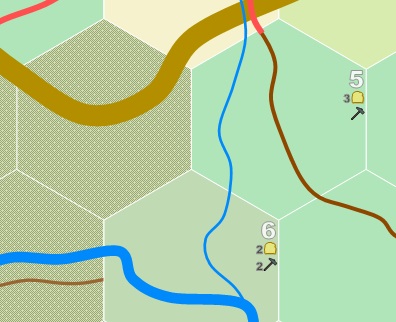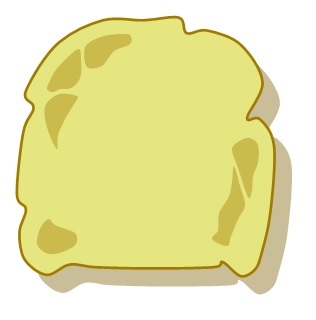Difference between revisions of "Bread (symbol)"
Tao alexis (talk | contribs) |
Tao alexis (talk | contribs) |
||
| Line 31: | Line 31: | ||
Any type of hex from 1 to 7 is considered a "cultivated" hex. Some type-8 hexes are considered "arable" but not yet cleared, when they occur in temperate climes, or adjacent to cultivated hexes, or are otherwise considered to possess water. Such type-8 hexes supply food through [[Foraging (sage ability)|foraging]] and [[Hunting (sage ability)|hunting]], and thus contribute to the overall surplus of food. Hexes that are designated as "mined" (see [[Hammer (symbol)#hammer location|hammer location]]) are not considered arable. There may be food there, enough to provide some subsistence, but that wouldn't count as surplus.<div style="clear: both"></div> | Any type of hex from 1 to 7 is considered a "cultivated" hex. Some type-8 hexes are considered "arable" but not yet cleared, when they occur in temperate climes, or adjacent to cultivated hexes, or are otherwise considered to possess water. Such type-8 hexes supply food through [[Foraging (sage ability)|foraging]] and [[Hunting (sage ability)|hunting]], and thus contribute to the overall surplus of food. Hexes that are designated as "mined" (see [[Hammer (symbol)#hammer location|hammer location]]) are not considered arable. There may be food there, enough to provide some subsistence, but that wouldn't count as surplus.<div style="clear: both"></div> | ||
| + | |||
| + | == Methods of Production == | ||
| + | Agricultural output occurs in part to the quality of soil and the farming practices that are employed. It's assumed that a type-4 hex has a better soil than a type-5, as the former's presence indicates, through the [[Infrastructure|infrastruction]] assignment method, that it's clearly more suitable for a larger population. Nonetheless, part of the benefit derived from the soil is accomplished through organisation of labour and mastering the existing conditions more efficiently. The table below therefore provides a general account of what sort of practice is performed according to the bread number and the hex-type. | ||
Revision as of 19:02, 1 September 2023
-
 6-mile map of a type-5 hex with 3 bread, a type-6 hex with 2 bread, and a type-8 (shape only) which is assumed to have 1 bread (not shown).
6-mile map of a type-5 hex with 3 bread, a type-6 hex with 2 bread, and a type-8 (shape only) which is assumed to have 1 bread (not shown).
Bread is a symbol used on game maps to represent the amount of food production in that space, upon which the world's population depends. The amount of bread designated in a hex is determined by the hex type, which in turn is a product of infrastructure. Hex types range from 1 to 8, with a "1" indicating a highly civilised hex and an "8" indicating uncivilised wilderness. Thus, type-1 and type-2 hexes possess much bread, while type-7 and type-8 hexes comparatively have very little.
Contents
| Hex Type % |
Bread Gained | |
|---|---|---|
| Rural | with Settlement | |
| 8 | 1 | 0 |
| 7 | 2 | 3 |
| 6 | 2 | 3 |
| 5 | 3 | 4 |
| 4 | 3 | 4 |
| 3 | 3 | 4 |
| 2 | 4 | 5 |
| 1 | 5 | 6 |
Bread Location
Bread is produced in cultivated or arable hexes, which are primarily farm or pasture land, with production much more rigidly fixed than with coins or hammers. Bread symbols count as surplus foods, over and above the needs of the residents — which means that while a type-6 hex produces more actual food than a type-7, it also consumed more and thus provides an equal surplus.
Any type of hex from 1 to 7 is considered a "cultivated" hex. Some type-8 hexes are considered "arable" but not yet cleared, when they occur in temperate climes, or adjacent to cultivated hexes, or are otherwise considered to possess water. Such type-8 hexes supply food through foraging and hunting, and thus contribute to the overall surplus of food. Hexes that are designated as "mined" (see hammer location) are not considered arable. There may be food there, enough to provide some subsistence, but that wouldn't count as surplus.
Methods of Production
Agricultural output occurs in part to the quality of soil and the farming practices that are employed. It's assumed that a type-4 hex has a better soil than a type-5, as the former's presence indicates, through the infrastruction assignment method, that it's clearly more suitable for a larger population. Nonetheless, part of the benefit derived from the soil is accomplished through organisation of labour and mastering the existing conditions more efficiently. The table below therefore provides a general account of what sort of practice is performed according to the bread number and the hex-type.
